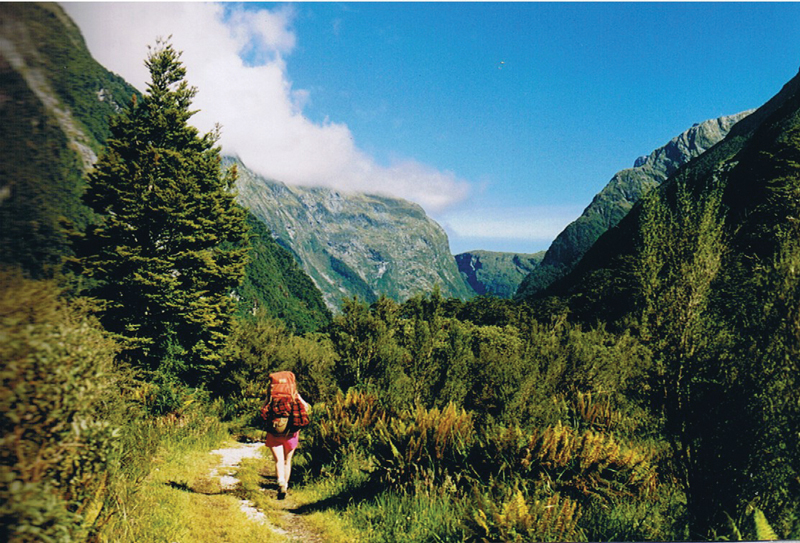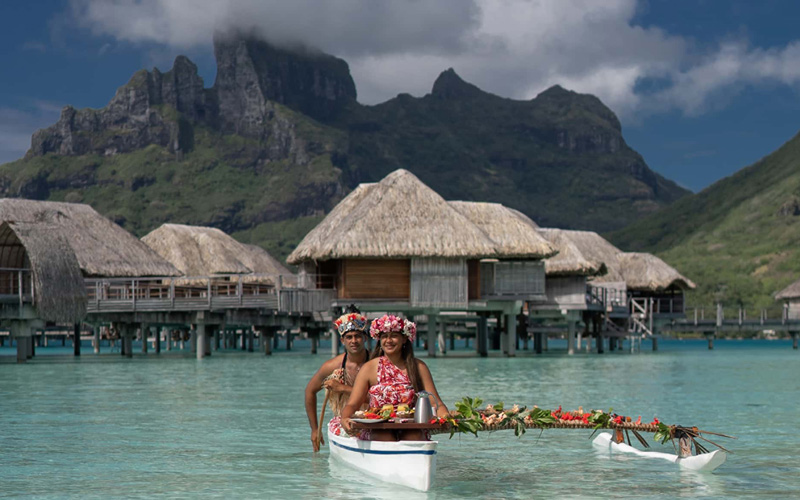The Most Beautiful Walk In The World
Exercise is important. New Zealand’s Milford Track,

known as the most beautiful walk in the world, the 33.5-mile, five day, four night trek – surpasses fitness. Alongside tranquil riverbeds, up and down an alpine mountain pass and through a giant fern forest, it’s an adventure into the wilderness
In the 1870’s, Quintin Mackinnon discovered this route between Te Anau and Milford Sound. Tracing Mackinnon’s steps is an opportunity of a lifetime.
Thirty-two hikers from six countries meet at Te Anau, the starting point of this South Island trek. The orientation is a preview of the next five days and a check of equipment.
“Now don’t forget your woolly-jumper, beanie, singlet, and torch,” says the guide.
I raise my hand and ask, “What should I do? Those things weren’t on my list.”
One of my fellow travelers leans over and taps my shoulder. “Do you have a sweater, a hat, an undershirt and a flashlight?”
“Of course,” I reply, “but not the things he mentioned.”
“Those are the things he mentioned!” says my new-found companion.
How will I survive? I do not even speak the same language.
The next morning, we board the bus to Lake Te Anau. The group hikes a soggy mile to Glade House. Here, as well as at Pompoloma Lodge and Quintin Huts, the innkeepers treat guests like long lost friends. Meals, hot showers, and even drying rooms for wet hiking clothes are provided. Evenings are filled with singing, games and conversation. Sleeping quarters are male and female dorms. Bedtime is a giant slumber party.
The real trek begins with the navigation of a suspended bridge. It feels like crossing a 20-foot ravine on a 100-foot hammock. But bridges get easier with practice.
Inverted images of the mountains and the beech-treed forests reflect on the water of the Clinton River. Like giant bags of marbles falling to the ground, waterfalls rush down the highlands from every direction. One merely must dip a cup in the cool, pure water of the falls or streams to quench a thirst.
After crossing giant slips, places where avalanches have completely obliterated the landscape, the path leads over piles of rock. Though stunning scenery is plentiful, wildlife is not. Flightless Kiwis, the New Zealand national bird, are nocturnal and rarely seen. Kea birds, green mountain parrots walk right up to you. Beware: they are quite adept at opening daypacks, ripping off food or destroying unattended hiking boots.
Our guide, Liz, regales us with stories of kea rampages. After her nightly slide presentation, she goes about the job of repairing blisters, sores, and bandaging ankles and knees. What a girl she is – a rosy-cheeked, waif of the world, filled with a joy of living and a love of the
simple life.
“The trip up to Mackinnon Pass is a wee grunt,” she tells us on the third night. “Then we have just a wee walk down.”
Really? The six-mile hike is almost vertical. After passing the hauntingly beautiful Lake Mintaro, the climb gets steeper and muddier. We grip our walking sticks to keep from stumbling. Sometimes, a solitary mountain lily emerges beside the path. Each of the 11 switchbacks becomes more rugged. Above the tree line, the temperature drops, yet there are three more zigzags to conquer.
“I don’t understand this,” says one of the Aussies. “I just followed my wife when she asked me to go for a walk! Next time I’m bringing Sherpas to carry me!”
Finally, the Quintin Mackinnon monument looms ahead. At 3,785 feet, we are enveloped in the naked beauty of snow-capped peaks and green valleys that few have the privilege to experience.
Amidst Mackinnon Pass’ incredible beauty sits an outhouse – “the loo with the view.” Everyone quickly comes down from the clouds and tends to the basics.
A 3-1/2 mile, 3,000-foot “wee” descent passes through the treacherous four R’s – rocks, rotten bog, running water and roots. The path leads through an emerald forest of giant, moss-laden tree ferns. Eerie shadows from these mysterious trees cast an aura of enchantment.
The last mile to the Quintin Huts takes forever. A fellow trekker greets me with an airline-sized bottle of brandy.
“Drink this,” he says, “You look like you need it.”
I chug down most of it to deaden my knee pain. The half-empty bottle still sits in my cosmetic case. It reminds me of the day I wished my legs were kneeless.
Our last hiking day passes the gushing waters of Sutherland Falls, the world’s fourth highest cascade. Nine-hundred-year-old tree stumps protrude out of Lake Ada, a lake formed by an avalanche nearly a thousand years ago. Our group photo at the foot of Giant Gate Falls is a keeper. And, each hiker poses alongside the old hiking boots that hang from the completion marker at Sandfly Point.
The jokes fly while waiting for the launch across Milford Sound.
“You mean I have to sleep with my wife tonight?” one of the guys says. “I’ve gotten used to the stereophonic sound of those
snoring dudes!”
The staff at the hotel treat us like we have just descended Mt. Everest. There is a special awards dinner and a morning Milford Sound celebration cruise. Porpoises, seals and penguins accompany the boat as it sails to the edge of the Tasman Sea.
A few of the group opt for a helicopter trip to Lake Quill, the lake that feeds Sutherland Falls. The steep pencil lines of the track are visible from the air making the hike seem more awesome. Melancholy sweeps through the group when bidding farewell to
newfound friends.
When I remember the stunning and diverse scenery and recall the sounds of carefree laughter, I am there once again. Like a favorite melody, it plays again and again in my brain.
www.newzealand.com




